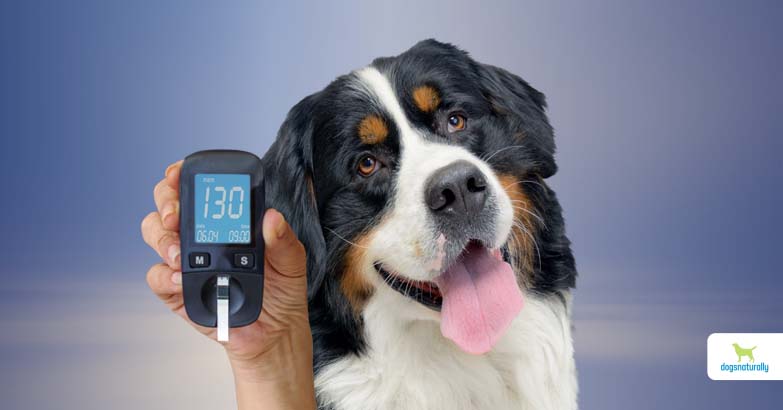According to the Merck Veterinary Manual, one out of every 300 dogs is diagnosed with diabetes (1). Especially in senior and middle aged dogs, diabetes in dogs is becoming frighteningly common. If your dog gets diabetes, he will most likely need insulin for the rest of his life. So it’s important to do everything you can to prevent your dog from becoming diabetic.
There are many things that can contribute to the risk of your dog getting diabetes … but the good news is, there are also lots of things you can do to help prevent it and minimize the risk.
Holistic veterinarian Dr Jean Hofve DVM explained the causes of diabetes in dogs, symptoms to watch for, and how to manage this chronic disease..
What is Diabetes?
Diabetes is all about how the body handles glucose. All cells use glucose as their main source of energy. But glucose can’t get into those cells without the help of insulin. Insulin is made by the pancreas.
Dr Hofve explains insulin as the key to a lock. The cells need the “key” (insulin) to let the glucose in.
When glucose can’t get into the cells without insulin, it builds up in the blood. This causes hyperglycemia, meaning too much sugar in the blood (hyper = too much, glyc = sugar and emia = in the blood) … aka high blood sugar.
This is why the pancreas and its production of insulin are so important. And when it’s not working right, your dog can become diabetic.
Types Of Diabetes
Dr Hofve explains that there are two types of diabetes.
Type 2 Diabetes
Type 2 diabetes is usually due to obesity and eating too many carbohydrates. In type 2 diabetes, there is plenty of insulin production, but the body becomes resistant to it because there is too much sugar coming in. Type 2 diabetes is the most common in people (90% of human diabetics have Type 2) – and it’s also the type of diabetes that cats get. This type of diabetes is reversible in some cases.
But dogs are different. Most diabetic dogs have Type 1 diabetes. And it’s a lot more serious.
Type 1 Diabetes
Type 1 diabetes is when the pancreas fails to produce insulin properly. This means glucose can’t get into the body’s cells to be used for energy. It’s quite dangerous, and it usually requires lifelong treatment with insulin shots. So you can see that preventing diabetes in dogs is really important.
And even though Type 1 diabetes isn’t caused by diet – Dr Hofve stresses that diet is a huge factor in preventing and managing it.
Dr Hofve has a lot of really good advice on how to do that. But first, how do you recognize the signs that your dog might have diabetes?
Signs Of Diabetes In Dogs
- Frequent urination – diabetic dogs drink a lot and pee a lot
- Hunger – your dog will be extra hungry because his cells are screaming for glucose
- Weight loss – because the cells can’t use sugar without insulin, your dog will start burning off tissue to produce more glucose, and he’ll lose weight
- Vomiting – this is common if your dog also has pancreatitis
- Weakness or fatigue
If you see these signs in your dog, you’ll want to have your vet test him for diabetes before his condition worsens.
Understanding what can increase the likelihood of diabetes is key to preventing it. So what are the risk factors?
Risk Factors For Diabetes
Here are some of the risk factors for diabetes. Keep reading below for more detail from Dr Jean Hofve on each of these risk factors. –
- Autoimmunity
- Breed or genetics
- GMOs (genetically modified organisms)
- Inflammation
- Metabolic syndrome
- Obesity
- Pancreatitis
- Toxins
- Vaccination
- Diet
Autoimmunity
Autoimmunity means the body attacks its own tissue and destroys it. If the beta cells that make insulin in the pancreas get destroyed, this causes diabetes (2). It can be triggered by a number of things:
- Leaky gut syndrome
- Infections
- Drugs including antibiotics
- Toxins (heavy metals, mold, endocrine-disrupting chemicals)
Breed
Here’s a list of breeds that are prone to diabetes. But diabetes isn’t limited to these breeds … any dog can get diabetes. Females get it twice as much as males (1, 3)).
- Alaskan Malamute
- Beagle
- Boxer
- Cairn Terrier
- Chow Chow
- Dachshund
- Doberman Pinscher
- Finnish Spitz
- German Shepherd Dog
- Golden Retriever
- Hungarian Puli
- Keeshond
- Labrador Retriever
- Miniature Pinscher
- Miniature Schnauzer
- Old English Sheepdog
- Poodle
- Samoyed
- Schipperke
- Springer Spaniel
- Tibetan Terrier
- West Highland White Terrier
Genetically Modified Organisms (GMOs)
GMOs contain many toxins that can damage your dog’s body.
95% of corn and soy are genetically engineered and if you feed kibble, your dog is eating them – unless it’s organic. GMOs are in Roundup weedkiller (glyphosate) and something called Bt toxin. Both are in and on crops at very high levels. Glyphosate is a highly toxic herbicide but Dr Hofve says Bt toxin is even more dangerous.
Bt Toxin
Bt toxin (Bacillus thuringiensis) kills worms and larvae – and it’s made from bacteria so it’s considered organic. This means organic farmers can use it … but beware! It’s a very, very vicious toxin (4).
Bt toxin is taken up in the cells of the plant, so when your dog (or the animal his meat comes from) eats the plant, he’ll then have Bt toxin in his system – along the whole digestive tract.
Bacteria transfer genes back and forth very easily. This means the Bt toxin gene gets into your dog’s own bacteria and he’ll have a Bt toxin factory in his gut that will operate for the rest of his life. The toxin can also continue through generations, because the mother passes it on to her puppies through the placenta.
This applies to you too. For example, if you get a steak in a restaurant, it was likely fed GMO corn, so you’ll get the gene through the meat. Bt toxin then creates endocrine disrupting chemicals in the body and it’s very dangerous.
Glyphosate
The reason they created GMOs was to prevent damage to crops, with the goal of making crops cheaper to feed more people. In theory, that’s a good goal. Except it’s not what happened.
Bugs and weeds are good at adapting to environment, so they learned to resist these toxins and started growing alongside corn that was produced to be resistant to toxins. So farmers added more and more herbicides to kill the resistant bugs and weeds.
And then there’s the wind, helping to spread it around. When you plant Roundup or Bt toxin-soaked plants upwind, the wind picks up the pollen and blows it. It can travel surprisingly far … glyphosate-contaminated pollen has been found 50 miles downwind, even years later.
These chemicals are in our food because they’re taken up by the plant … they’re inside the soybean and the corn and you can’t wash them off. These toxins cause oxidative stress and inflammation as well as DNA damage. They’re very dangerous and it’s really important to eat (or feed your dog) organic food as much as you can.
Inflammation
Inflammation isn’t all bad. It’s actually a normal body response that’s part of the healing process. It removes dead tissues and brings in immune cells to fight infection.
Inflammation can be caused by …
- Injury
- Infection
- Stress
- Certain foods (like sugar and gluten)
- Body fat
Inflammation is only a problem if it gets out of hand. If this happens, it can cause pancreatitis, autoimmune disease, leaky gut and many other chronic diseases.
Metabolic Syndrome
In humans, metabolic syndrome is the name for a group of risk factors that raise the risk for …
- Heart disease
- Type 2 diabetes
- Atherosclerosis
- Kidney damage
- Brain degeneration
- Stroke
The term metabolic syndrome is now being used broadly for obese dogs who develop insulin resistance and other metabolic syndrome symptoms such as …
- Obesity
- Insulin resistance
- Glucose intolerance
- Vascular inflammation
- Altered lipid profile (like high cholesterol)
There are disagreements among experts as to whether metabolic syndrome truly exists in dogs (5, 6). But it’s a chicken or egg situation – does diabetes cause metabolic syndrome, or vice versa? They do go hand in hand, so keep an eye on your dog for metabolic syndrome symptoms.
Obesity
More than half of US dogs are overweight or obese … and there are more every year.
Dr Hofve feels most veterinarians don’t take obesity seriously enough, with many vets saying things like “Fluffy could lose a pound or two” … but not stressing the importance of weight loss nearly enough.
Dr Hofve says chubby animals may be cute, but it’s actually serious abuse to let your dog become obese. Excess weight causes arthritis, heart disease, skin problems and more. Researchers at New York’s The Animal Medical Center and University of Illinois College of Veterinary Medicine agree, stating …
“Excess body fat has adverse metabolic consequences, including insulin resistance, altered adipokine secretion, changes in metabolic rate, abnormal lipid metabolism, and fat accumulation in visceral organs. […] A connection likely also exists between obesity and diabetes mellitus in dogs.”
Fat cells secrete hormones and chemical messengers that promote inflammation. Obesity is a chronic pro-inflammatory state that contributes to risk factors for both pancreatitis and diabetes. Weight loss is essential for good diabetes management. What your dog eats and how much you exercise him can make a big difference in his tendency to become diabetic.
Pancreatitis
Pancreatitis and diabetes mellitus in dogs are often linked (8). The pancreas produces hormones and digestive enzymes. Pancreatitis destroys beta cells in the pancreas – and remember, beta cells are the ones that produce insulin. 25% of diabetic dogs have or have had pancreatitis.
David Bruyette DVM hDACVIM in the Merck Veterinary Manual says, “Chronic relapsing pancreatitis with progressive loss of both exocrine and endocrine cells and their replacement by fibrous connective tissue results in diabetes mellitus.” (1)
Dr Hofve explains further:
“When the cells get inflamed, they swell up and get leaky. And when you have leaky gut, you get substances leaking into the blood stream that shouldn’t be there. The digestive enzymes produced by the pancreas get loose and start destroying the surrounding tissue. They break it down and turn it into liquid (think about what happens if you leave an old bag of lettuce in the fridge by mistake – it turns into a bag of brown water!)
“When the beta cells get destroyed, this causes diabetes because there’s no insulin being produced.”
The most common cause of pancreatitis in dogs is dietary fat. This might be a one-time occurrence (like your dog getting into the garbage) or it could be chronic intake of a high fat diet. It’s important to control your dog’s fat intake to help prevent pancreatitis and diabetes.
Toxins
In addition to glyphosate and Bt toxin mentioned earlier, there are other toxins that can contribute to the likelihood of diabetes.
BPA (Bisphenol A) And Other Endocrine-Disrupting Chemicals
Most people are aware that BPAs are contained in many plastic containers. But it’s in other places too – for example, the cash register receipts you get at the grocery store contain BPAs. Many food cans are lined with plastic that contains BPAs as well. So do your research to avoid these substances, as they are linked to obesity as well as cancer.
Aflatoxin And Other Molds
Aflatoxin molds in dog food have led to illness and death of many pets. It’s almost impossible to have aflatoxin-free corn. It may be too moldy for human use but it’s still used in animal food. These molds can also contaminate meat and fish – and nobody’s testing for that!
Vaccines
Over-vaccination may contribute to autoimmune disease, including diabetes, according to research.
In a 2017 report (9) Laurel Gershwin DVM at UC Davis reviewed many adverse effects of vaccines. On the topic of autoimmunity, she found it unlikely that vaccination directly causes autoimmunity, but she did say …
” …it is likely that a combination of genetics, environmental factors, and overstimulation of the immune system (which can occur as a result of overvaccination) contribute to the development of many autoimmune diseases.”
However, in 1999 Purdue University researchers Hogenesch et al (10) did find that vaccinated dogs developed autoantibodies to their own tissues. The study stated …
“In conclusion, we have demonstrated that vaccination of dogs using a routine protocol and commonly used vaccines, induces autoantibodies.”
The Influence Of Diet On Diabetes In Dogs
Diet doesn’t directly cause Type 1 diabetes, but it does cause many other risk factors: obesity, inflammation, pancreatitis, metabolic syndrome and autoimmune disease.
There are six classes of nutrients:
- Proteins
- Fat
- Carbohydrates
- Vitamins
- Minerals
- Water (people forget this one!)
Protein, fats and carbs are all sources of energy (calories).
Protein
Carnivores like your dog need meat and can’t be really healthy without it. It’s the most expensive ingredient in pet food so they don’t put much of it in the food – in fact, most companies use the very smallest amount they can get away with, to increase profits. You should feed your dog at least 30% protein to minimize the risk of diabetes.
Carbohydrates
Once your dog has been weaned from his mom, he has no requirement for carbohydrates – none at all! In this article by animal nutritionist Dr Richard S Patton PhD, he explains why mammals, including dogs have no ability to deal with constant excess starch and sugar. .
“As four billion years of evolution adapted all creatures to their surroundings, constant high levels of starch and sugar were never encountered. If you analyze anything that might constitute food or nourishment, anywhere in the world, it will be low in starch and sugar.”
Richard S Patton PhD
But, carbs are the cheapest ingredients, so pet food companies put a lot of them in dog foods. They’re also what holds the kibble together. Carbs will make your dog fat because grains and starchy vegetables break down into sugar very fast, and the excess is stored as fat.
Note: Fiber is different. Fiber is an indigestible carbohydrate, so it doesn’t contribute calories … and dogs who eat a high fiber diet tend to be leaner. It does help your dog feel full so adding fiber like non-starchy vegetables can help your dog lose weight.
Fat
Fat is necessary in the diet as it’s the basis of all the hormones. But one big problem with fat is the increased potential for pancreatitis … that can lead to diabetes. Even one big dose of a really fatty food can cause a problem (like giving your dog the skin off your Thanksgivingurkey!).
Long term feeding of a high fat diet can also cause pancreatitis. A lot of home made raw diets are quite high in fat, and even some raw frozen diets contain a lot of fat. So if your dog’s overweight or is a breed susceptible to diabetes, it’s a good idea to feed him extra green leafy vegetables to keep the fat down and increase fiber.
Fat Types
The type of fat you feed is important.
- Omega-6: these fats promote inflammation. Dogs get plenty of omega-6 in their diets (unless you’re feeding all pastured meats, free range eggs etc) and you usually don’t need to supplement it.
- Omega-3: these are important and usually need to be supplemented. Sources like green-lipped mussels are much better than fish oils that can turn rancid very easily.
- Omega-9: there’s no need to give omega-9 fats like olive oil.
Helpful Additions To Your Dog’s Diet
Antioxidants
Antioxidant foods fight free radicals that cause inflammation, aging, degenerative diseases and tissue damage. They’re the plant pigments that give fruit and vegetables their color. Feed foods rich in antioxidants like berries, other colorful fruit and veggies, and even parsley is a powerful antioxidant.
Probiotics
Give these friendly bacteria to keep your dog’s gut and digestive tract healthy and support his immune system. A 2019 veterinary study found altered gut bacterial populations in diabetic dogs (11). Give your dog a good quality probiotic as some products made for pets have been found to contain no live organisms!
Curcumin
This is an excellent antioxidant and it’s been shown to help with cell regeneration (12). Dr Hofve suggest’s it’s one of the very few things that may actually help beta cells regenerate. If you have a dog with beginning diabetes you may be able to get some of those beta cells working again.
Berberine
Berberine has long been used in China to treat diabetes and it’s come a popular to help manage diabetes among Western practitioners too. Studies show it helps lower blood glucose by lowering glucose absorption (13,14)). In human diabetics, studies report it lowers insulin resistance and is a good alternative to the diabetes drug Metformin.
It’s important to ask your herbalist or holistic vet about the dosage that’s best for your dog, as you don’t want to overdo berberine.
Digestive Enzymes
Dr Hofve suggests that adding digestive enzymes can help your dog get more nutrition out of his food and may help reduce the burden on a compromised pancreas, as well as aid digestion. Find one that contains pancreas or pancreatic enzymes if you can. Dr Frederick Banting, who discovered insulin, reported in 1921 in the Canadian Medical Journal that pancreatic extract could lower blood glucose … and that’s what led him to isolate insulin as a diabetes medication (15).
Follow these guidelines to help keep your dog diabetes-free. If your dog does develop diabetes, this advice will also help manage his condition and may help you minimize the need for insulin.
References
- David Bruyette DVM DACVIM. Diabetes Mellitus in Dogs And Cats. Merck Veterinary Manual. Revised July 2019.
- Catchpole, B, et al. Canine diabetes mellitus: can old dogs teach us new tricks?Diabetologia, 2005 Oct;48(10):1948-56. doi: 10.1007/s00125-005-1921-1. Epub 2005 Sep 8.
- L Guptill, L Glickman, N Glickman. Time Trends and Risk Factors for Diabetes Mellitus in Dogs: Analysis of Veterinary Medical Data Base Records (1970–1999). The Veterinary Journal,Volume 165, Issue 3, 2003.
- Then C, Bauer-Panskus A. Possible health impacts of Bt toxins and residues from spraying with complementary herbicides in genetically engineered soybeans and risk assessment as performed by the European Food Safety Authority EFSA. Environ Sci Eur. 2017;29(1):1.
- Tvarijonaviciute A, Ceron JJ, Holden SL, Cuthbertson DJ, Biourge V, Morris PJ, German AJ. Obesity-related metabolic dysfunction in dogs: a comparison with human metabolic syndrome. BMC Vet Res. 2012 Aug 28;8:147. doi: 10.1186/1746-6148-8-147.
- Verkest KR. Is the metabolic syndrome a useful clinical concept in dogs? A review of the evidence. Vet J. 2014 Jan;199(1):24-30.
- Clark M, Hoenig M. Metabolic Effects of Obesity and Its Interaction with Endocrine Diseases. Vet Clin North Am Small Anim Pract. 2016 Sep;46(5):797-815.
- Davison LJ. Diabetes mellitus and pancreatitis–cause or effect? J Small Anim Pract. 2015 Jan;56(1):50
- Gershwin LJ. Adverse Reactions to Vaccination: From Anaphylaxis to Autoimmunity. Vet Clin North Am Small Anim Pract. 2018 Mar;48(2):279-290.
- Hogenesch H, Azcona-Olivera J, Scott-Moncrieff C, et al. Vaccine-induced autoimmunity in the dog. Adv Vet Med 1999;41:733–47.
- Jergens Albert E. et al. Microbiota-Related Changes in Unconjugated Fecal Bile Acids Are Associated With Naturally Occurring, Insulin-Dependent Diabetes Mellitus in Dogs. Frontiers in Veterinary Science Vol 6 2019.
- Ganugula, R.et al (2017) Nano-curcumin safely prevents streptozotocin-induced inflammation and apoptosis in pancreatic beta cells for effective management of Type 1 diabetes mellitus. British Journal of Pharmacology, 174: 2074– 2084.
- Guo-Yu Pan et al. The Antihyperglycaemic Activity of Berberine Arises from a Decrease of Glucose Absorption. Planta Med 2003; 69(7): 632-636
- Zhang H et al. Berberine lowers blood glucose in type 2 diabetes mellitus patients through increasing insulin receptor expression. Metabolism. 2010 Feb;59(2):285-92.
- FG Banting et al. Pancreatic exracts in the treatment of diabetes mellitus. Can Med Assoc Journal. Sept 1021.












